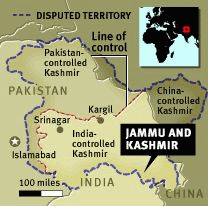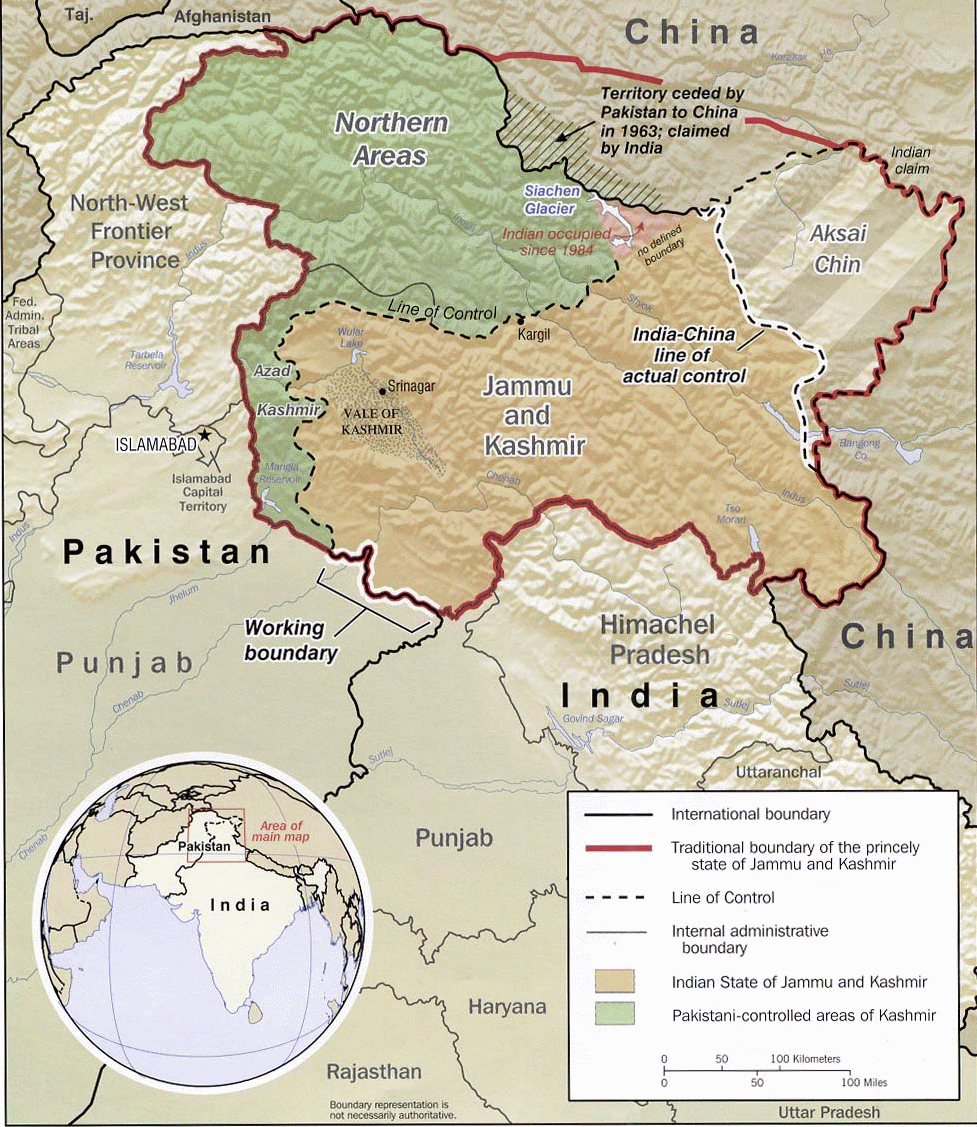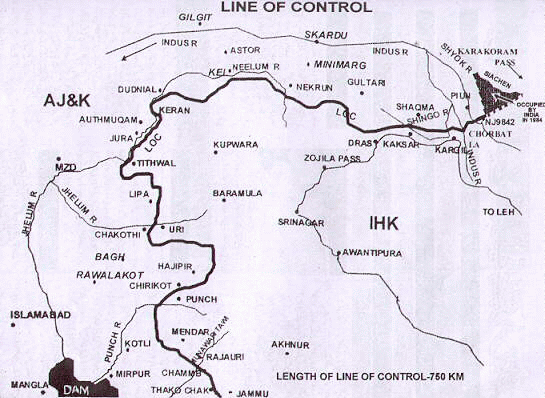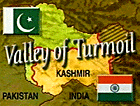
Kashmir -
The Valley under Siege
 In modern times, there two issues
that have hijacked the the world peace - the Palestine and Kashmir disputes.
Interestingly both stemmed almost at the same time into the history and have
similar cause - injustice to the indigenous people. The Palestinians and the
Kashmiris have since been denied to have their own homeland and their voice for
independence from the shackles of slavery is being brutally silenced. The very
issue has brought the Arabs and Israel, and Pakistan and India to the battle
fronts three-four times, but the deadlock continues. This site is focused on the
Kashmir dispute, its genesis and the present position. However, the irony of the
matter is that while the world community has tried to resolve many such issues
by active involvement including the UN, the fate of Kashmir is left to be
resolved mutually between India and Pakistan.
In modern times, there two issues
that have hijacked the the world peace - the Palestine and Kashmir disputes.
Interestingly both stemmed almost at the same time into the history and have
similar cause - injustice to the indigenous people. The Palestinians and the
Kashmiris have since been denied to have their own homeland and their voice for
independence from the shackles of slavery is being brutally silenced. The very
issue has brought the Arabs and Israel, and Pakistan and India to the battle
fronts three-four times, but the deadlock continues. This site is focused on the
Kashmir dispute, its genesis and the present position. However, the irony of the
matter is that while the world community has tried to resolve many such issues
by active involvement including the UN, the fate of Kashmir is left to be
resolved mutually between India and Pakistan.
The Facts:

Kashmir is located in the North
and North-East of Pakistan, sharing its border with Afghanistan, China and
India. Kashmir has been divided into two segments, one under the Indian control
and the other under Pakistan. The IHK is further subdivided into three regions:
the Valley, Jammu and Ladakh. Kashmir Valley has 4% Hindus and 95% Muslims,
while Jammu has Hindu majority (66%) while Muslims are 30% with 4% other
religions. Ladakh is 50% Buddhist, 46% Muslims and others 3%. The Azad Kashmir
has Muslim majority of almost 99%.
Kashmir Dispute in
Historical Perspective: Kashmir has all along
a Muslim majority part of the undivided India - an area with 94% Muslim
population - but was sold to the Sikhs by the British in 1846 as a reward of
their loyalty to the British Empire. Thus began an era of suppression of the
Muslims by the rulers of Kashmir which continued till the partition of undivided
India in august 1947. In 1931, the people of Kashmir stood up for the first time
and protested against the atrocities of Maharajah Hari Singh. This movement led
to the "Quit Kashmir" campaign against the Maharajah in 1946. The Muslims of
India under Jinnah always dreamt of a separate homeland comprising all Muslim
majority areas, including the Kashmir Valley - even the letter "K" in the word
"Pakistan" stands for Kashmir when on 23 March 1940, the famous Pakistan
resolution was adopted unanimously by the Muslim League - the sole
representative political party of all Muslims living in the British India. On
July 26, 1946, the Muslim Conference adopted the Azad Kashmir Resolution,
calling for the end of autocratic rule in the region. The resolution also
claimed for Kashmiris right to elect their own constituent assembly.
The genesis of the issue were
first sowed by the British when announcing the partition plan on June 3, 1947,
wherein while accepting Muslims' view point of dividing India in a manner that
all Muslim majority regions go to the newly formed state of Pakistan and the
rest to India. But perhaps at the back of their mind was something else. The
boundary commission under Sir Radcliff provided the base - which acceded the
Muslim majority district of Gurdaspur to India and was tacitly announced just a
few days before the partition. The importance of Gurdaspur is that it
provided the only road link between India and Kashmir Valley. This obviously
created resentment among the Muslims of the Kashmir Valley and present northern
areas of Pakistan.
 Thus an armed struggle started off between the Kashmiri
Muslims and the forces of Maharaja Hari Singh. Although, as per the provisions
of the independence, the rulers of all independent states were given the option
to join either of the two states. Under mounting pressures of the Muslim
fighters, the Maharaja opted to join India and asked India for military support.
The Indians promised military support provided the Maharaja signed the
"Instrument of Accession" document. The moment the document was signed, Indian
forces entered Kashmir using Srinagar airfield.
Faced with a popular revolt against
his rule, the Maharajah fled to Jammu on 25th October 1947 and received a commitment of military assistance from the Indian
government in exchange for his signing the "Instrument of Accession" document.
Lord Mountbatten conditionally accepted the document on behalf of the British
Crown and outlined the conditions for official acceptance in a letter
dated 27th October 1947. "In consistence with their policy that in the case of
any (native) state where the issue of accession has been subject of dispute, the
question of accession should be decided in accordance with the wishes of the
people of the state, it is my government's wish that as soon as law and order
have been restored in Kashmir and her soil cleared of the invaders the question
of state's accession should be settled by a reference to the people." On 1
November 1947 Jinnah categorically announced that Kashmir's accession to India
was not "bona fide" when he met Governor General of India, Mountbatten.
Interestingly, the following day, Indian Prime Minister, Jawaharlal Nehru, in
a speech aired on All-India Radio, reaffirmed the Indian Government's commitment
to the right of the Kashmiri people to determine their own future through a
plebiscite: "We have declared that the fate of Kashmir is ultimately to be
decided by the people. That pledge we have given, and the Maharajah has
supported it, not only to the people of Jammu and Kashmir, but also to the
world. We will not and cannot back out of it. We are prepared when peace and law
have been established to have a referendum held under international auspices
like the United Nations. We want it to be a fair and just reference to the
people and we shall accept their verdict." However, events thereafter bore
testimony to the Indian hypocrisy since till date this promise has not been
fulfilled by successive Indian governments.
Thus an armed struggle started off between the Kashmiri
Muslims and the forces of Maharaja Hari Singh. Although, as per the provisions
of the independence, the rulers of all independent states were given the option
to join either of the two states. Under mounting pressures of the Muslim
fighters, the Maharaja opted to join India and asked India for military support.
The Indians promised military support provided the Maharaja signed the
"Instrument of Accession" document. The moment the document was signed, Indian
forces entered Kashmir using Srinagar airfield.
Faced with a popular revolt against
his rule, the Maharajah fled to Jammu on 25th October 1947 and received a commitment of military assistance from the Indian
government in exchange for his signing the "Instrument of Accession" document.
Lord Mountbatten conditionally accepted the document on behalf of the British
Crown and outlined the conditions for official acceptance in a letter
dated 27th October 1947. "In consistence with their policy that in the case of
any (native) state where the issue of accession has been subject of dispute, the
question of accession should be decided in accordance with the wishes of the
people of the state, it is my government's wish that as soon as law and order
have been restored in Kashmir and her soil cleared of the invaders the question
of state's accession should be settled by a reference to the people." On 1
November 1947 Jinnah categorically announced that Kashmir's accession to India
was not "bona fide" when he met Governor General of India, Mountbatten.
Interestingly, the following day, Indian Prime Minister, Jawaharlal Nehru, in
a speech aired on All-India Radio, reaffirmed the Indian Government's commitment
to the right of the Kashmiri people to determine their own future through a
plebiscite: "We have declared that the fate of Kashmir is ultimately to be
decided by the people. That pledge we have given, and the Maharajah has
supported it, not only to the people of Jammu and Kashmir, but also to the
world. We will not and cannot back out of it. We are prepared when peace and law
have been established to have a referendum held under international auspices
like the United Nations. We want it to be a fair and just reference to the
people and we shall accept their verdict." However, events thereafter bore
testimony to the Indian hypocrisy since till date this promise has not been
fulfilled by successive Indian governments.
India and Pakistan went to war over Kashmir from 1947-48. When India could not
find a way out of the problem, India brought the Kashmir issue to UN Security Council in January 1948. The rebel forces had been joined by volunteers
from Pakistan and India charged Pakistan with having sent "armed raiders" into
the state. It demanded that Pakistan be declared an aggressor in Kashmir.
Furthermore, India demanded that Pakistan stop aiding freedom fighters, and
allowing the transit of tribesmen into the state. After acceptance of these
demands, coupled with the assurance that all "raiders" were withdrawn, India
would allow a plebiscite to be held under impartial auspices to decide Kashmir's
future status. The Security
Council discussed the question from January until April of 1948. It came to the
conclusion that it would be impossible to determine responsibility for the
fighting and futile to blame either side. Since both parties desired that the
question of accession should be decided through an impartial plebiscite, the
council developed proposals based on the common ground between them.
These were embodied in the resolution of 21st April 1948, envisaging:
-
An immediate cease-fire,
-
Withdrawal of all outside forces
from the state, and
-
A plebiscite under the control of
an administrator who would be nominated by the Secretary General.
For negotiating the details of the plan, the council
constituted a five-member commission known as "United Nations Commission for
India and Pakistan," (UNCIP) to implement the resolution. After the
cease-fire, India began efforts to drag the issue down, and under various
pretexts tried to stop the UN resolution from being implemented. To this day,
India pursues the same plan, and the resolution of 1948 has yet to be realized.
The UN also deployed the United Nations Military Observer Group (UNMOGIP) to
monitor the cease-fire line between the Liberated or Azad Kashmir area and the
Indian Held Kashmir (IHK).

However, despite UN resolutions, there has been no solution to the problem and
India and Pakistan fought two more wars in 1965 and 1971. But no solution has
since been found since India continues to maintain its right over entire
Kashmir, even the portion held by Pakistan. The views of Indian Defence Minister
Krishan Menon are worth quoting here who in February 1957 said," "I wish to make
it clear on behalf of my government that in no circumstances we can agree to the
holding of a plebiscite in Kashmir." After 1971 Indo-Pak war, Pakistan and
India signed the famous Simla Agreement and agreed to make efforts toward establishing durable peace by
seeking a solution to existing problems, including "a final settlement of Jammu
and Kashmir." And so much for the the dispute, since the status quo
continues till date.
After more than four decades of a
peaceful struggle against Indian repression, manipulation and exploitation, the
Kashmiri people, convinced that India would never honour its commitments, and
inspired by similar movements for freedom in other parts of the world, rose
against the Indian occupation towards the later part of 1989. Their struggle
was, and remains, largely peaceful. India sought to suppress their movement with
massive use of force, killing hundreds of innocent men, women and children. This
led some of the Kashmiri youth to take up arms in self defence. Since 1989, more
than 60,000 Kashmiri people have been killed in a reign of terror and repression
unleashed by over 600,000 Indian troops. Many more languish in Indian jails
where they are subjected to torture and custodial deaths. There have been
numerous cases of gang rapes of Kashmiri women by the Indian forces and the
deliberate burning down of entire localities and villages.
The recent initiatives by the President of Pakistan of total withdrawal of
troops from Kashmir and joint control of Kashmir have also not been accepted and
the stalemate continues despite the recent on going dialogues between Pakistan
and India wherein India is ready to discuss any issue less Kashmir.
Others' View Point on
Kashmir Dispute
This page was created on 13 March 2006 /
 16 March 2005
16 March 2005

Copyright©JalalsPages - 2005
 In modern times, there two issues
that have hijacked the the world peace - the Palestine and Kashmir disputes.
Interestingly both stemmed almost at the same time into the history and have
similar cause - injustice to the indigenous people. The Palestinians and the
Kashmiris have since been denied to have their own homeland and their voice for
independence from the shackles of slavery is being brutally silenced. The very
issue has brought the Arabs and Israel, and Pakistan and India to the battle
fronts three-four times, but the deadlock continues. This site is focused on the
Kashmir dispute, its genesis and the present position. However, the irony of the
matter is that while the world community has tried to resolve many such issues
by active involvement including the UN, the fate of Kashmir is left to be
resolved mutually between India and Pakistan.
In modern times, there two issues
that have hijacked the the world peace - the Palestine and Kashmir disputes.
Interestingly both stemmed almost at the same time into the history and have
similar cause - injustice to the indigenous people. The Palestinians and the
Kashmiris have since been denied to have their own homeland and their voice for
independence from the shackles of slavery is being brutally silenced. The very
issue has brought the Arabs and Israel, and Pakistan and India to the battle
fronts three-four times, but the deadlock continues. This site is focused on the
Kashmir dispute, its genesis and the present position. However, the irony of the
matter is that while the world community has tried to resolve many such issues
by active involvement including the UN, the fate of Kashmir is left to be
resolved mutually between India and Pakistan. 

 Thus an armed struggle started off between the Kashmiri
Muslims and the forces of Maharaja Hari Singh. Although, as per the provisions
of the independence, the rulers of all independent states were given the option
to join either of the two states. Under mounting pressures of the Muslim
fighters, the Maharaja opted to join India and asked India for military support.
The Indians promised military support provided the Maharaja signed the
"Instrument of Accession" document. The moment the document was signed, Indian
forces entered Kashmir using Srinagar airfield.
Faced with a popular revolt against
his rule, the Maharajah fled to Jammu on 25th October 1947 and received a commitment of military assistance from the Indian
government in exchange for his signing the "Instrument of Accession" document.
Lord Mountbatten conditionally accepted the document on behalf of the British
Crown and outlined the conditions for official acceptance in a letter
dated 27th October 1947. "In consistence with their policy that in the case of
any (native) state where the issue of accession has been subject of dispute, the
question of accession should be decided in accordance with the wishes of the
people of the state, it is my government's wish that as soon as law and order
have been restored in Kashmir and her soil cleared of the invaders the question
of state's accession should be settled by a reference to the people." On 1
November 1947 Jinnah categorically announced that Kashmir's accession to India
was not "bona fide" when he met Governor General of India, Mountbatten.
Interestingly, the following day, Indian Prime Minister, Jawaharlal Nehru, in
a speech aired on All-India Radio, reaffirmed the Indian Government's commitment
to the right of the Kashmiri people to determine their own future through a
plebiscite: "We have declared that the fate of Kashmir is ultimately to be
decided by the people. That pledge we have given, and the Maharajah has
supported it, not only to the people of Jammu and Kashmir, but also to the
world. We will not and cannot back out of it. We are prepared when peace and law
have been established to have a referendum held under international auspices
like the United Nations. We want it to be a fair and just reference to the
people and we shall accept their verdict." However, events thereafter bore
testimony to the Indian hypocrisy since till date this promise has not been
fulfilled by successive Indian governments.
Thus an armed struggle started off between the Kashmiri
Muslims and the forces of Maharaja Hari Singh. Although, as per the provisions
of the independence, the rulers of all independent states were given the option
to join either of the two states. Under mounting pressures of the Muslim
fighters, the Maharaja opted to join India and asked India for military support.
The Indians promised military support provided the Maharaja signed the
"Instrument of Accession" document. The moment the document was signed, Indian
forces entered Kashmir using Srinagar airfield.
Faced with a popular revolt against
his rule, the Maharajah fled to Jammu on 25th October 1947 and received a commitment of military assistance from the Indian
government in exchange for his signing the "Instrument of Accession" document.
Lord Mountbatten conditionally accepted the document on behalf of the British
Crown and outlined the conditions for official acceptance in a letter
dated 27th October 1947. "In consistence with their policy that in the case of
any (native) state where the issue of accession has been subject of dispute, the
question of accession should be decided in accordance with the wishes of the
people of the state, it is my government's wish that as soon as law and order
have been restored in Kashmir and her soil cleared of the invaders the question
of state's accession should be settled by a reference to the people." On 1
November 1947 Jinnah categorically announced that Kashmir's accession to India
was not "bona fide" when he met Governor General of India, Mountbatten.
Interestingly, the following day, Indian Prime Minister, Jawaharlal Nehru, in
a speech aired on All-India Radio, reaffirmed the Indian Government's commitment
to the right of the Kashmiri people to determine their own future through a
plebiscite: "We have declared that the fate of Kashmir is ultimately to be
decided by the people. That pledge we have given, and the Maharajah has
supported it, not only to the people of Jammu and Kashmir, but also to the
world. We will not and cannot back out of it. We are prepared when peace and law
have been established to have a referendum held under international auspices
like the United Nations. We want it to be a fair and just reference to the
people and we shall accept their verdict." However, events thereafter bore
testimony to the Indian hypocrisy since till date this promise has not been
fulfilled by successive Indian governments.


